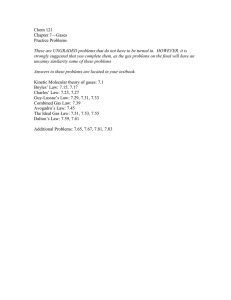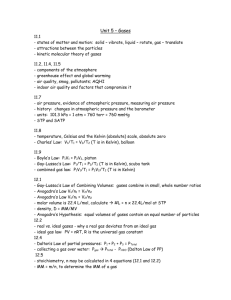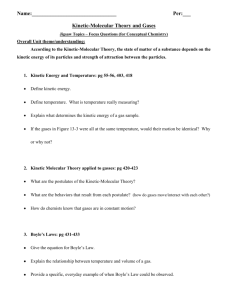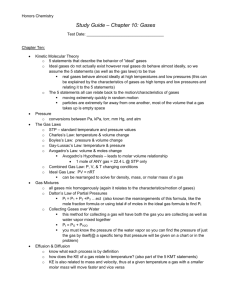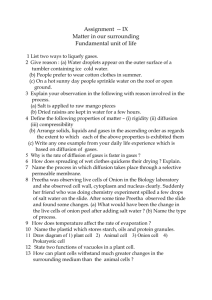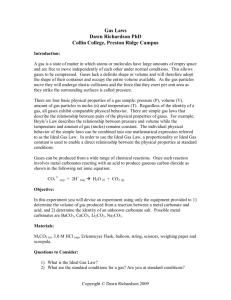Unit 1: Introduction to Chemistry
advertisement
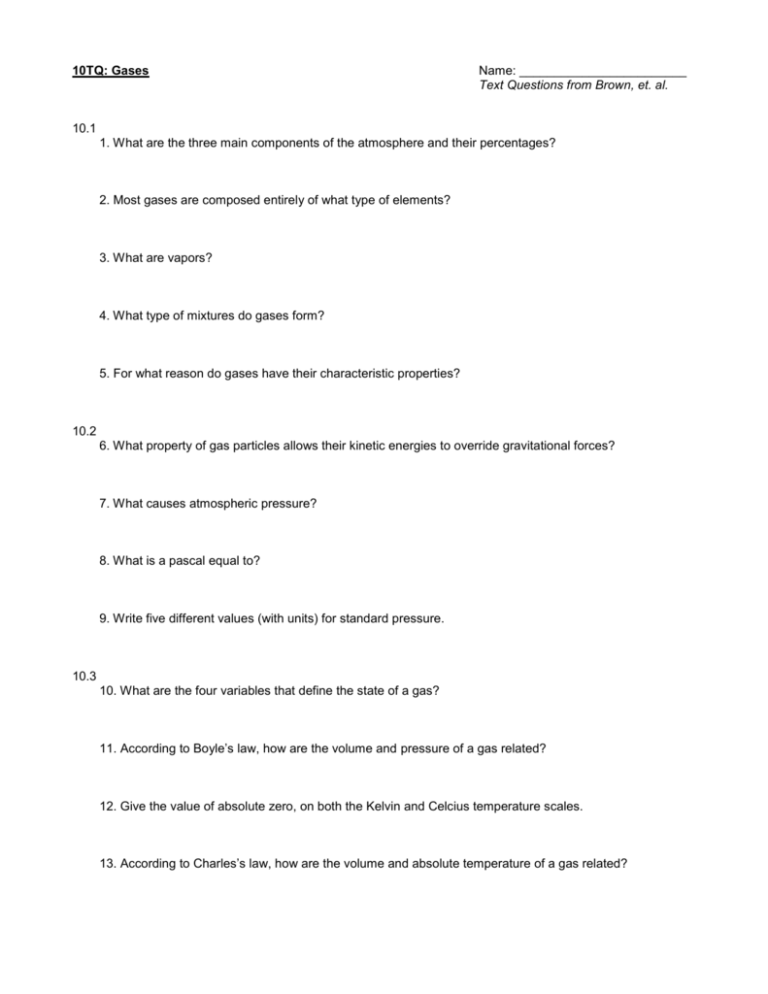
10TQ: Gases Name: ________________________ Text Questions from Brown, et. al. 10.1 1. What are the three main components of the atmosphere and their percentages? 2. Most gases are composed entirely of what type of elements? 3. What are vapors? 4. What type of mixtures do gases form? 5. For what reason do gases have their characteristic properties? 10.2 6. What property of gas particles allows their kinetic energies to override gravitational forces? 7. What causes atmospheric pressure? 8. What is a pascal equal to? 9. Write five different values (with units) for standard pressure. 10.3 10. What are the four variables that define the state of a gas? 11. According to Boyle’s law, how are the volume and pressure of a gas related? 12. Give the value of absolute zero, on both the Kelvin and Celcius temperature scales. 13. According to Charles’s law, how are the volume and absolute temperature of a gas related? 14. What is Avogadro’s hypothesis? 15. What is Avogadro’s law? 10.4 16. What is an ideal gas? 17. Give two values – having different units – for the gas constant. 18. Give the values of standard temperature, standard pressure, and the molar volume. 19. Is the ideal gas equation exactly correct for real gases? 20. Write the combined gas law equation and tell what remains constant when using the equation. 10.5 21. Write the equation for density that is unique to gases and define each variable. 10.6 22. What important observation did John Dalton make while studying the properties of air? 23. What does Dalton’s partial pressure equation imply? 24. At constant T and V, what determines the total pressure? 25. The mole fraction, X, is a dimensionless number that expresses what ratio? 26. The partial pressure of a gas in a mixture is equal to the product of what two quantities? 27. When collecting gases over water, why is the collecting vessel raised or lowered to make the water levels inside and out the same? 10.7 28. What is another name for the kinetic-molecular theory? 29. The average kinetic energy of molecules is proportional to what? 30. The magnitude of the pressure exerted by a gas is determined by what two factors? 31. In a given sample of any gas, the particles have WHAT at any given instant? 32. What happens to a gas’s velocity-distribution curve as the gas’s temperature increases? 10.8 33. For a given temperature, how does the rms speed of a lighter gas compare to that of a heavier gas? 34. Write the equation for calculating rms speed, and define the terms. 35. What is the difference between effusion and diffusion? 36. Write the equation for Graham’s law and define the terms. 37. Why is the diffusion of gases much slower than molecular speeds? 38. About how many collisions occur per second per gas particle? 39. Why do collisions occur? 40. What is meant by the mean free path? 41. What is the approximate value of the mean free path for air molecules at sea level? 10.9 42. Real gases deviate from ideal behavior under what two conditions? 43. At high pressures, how do actual gas volumes compare to those predicted by the ideal gas equation? 44. When attractive forces become significant, what happens to the magnitude of the impact of a given particle with the wall of the container? 45. Temperature determines the effectiveness of what? 46. Write the van der Waals equation. 47. Which factor accounts for the attractive forces? 48. What does the nb factor account for? 49. The constants a and b are ____________ for each gas and are determined… 50. The constants a and b increase along with an increase in what two factors?
